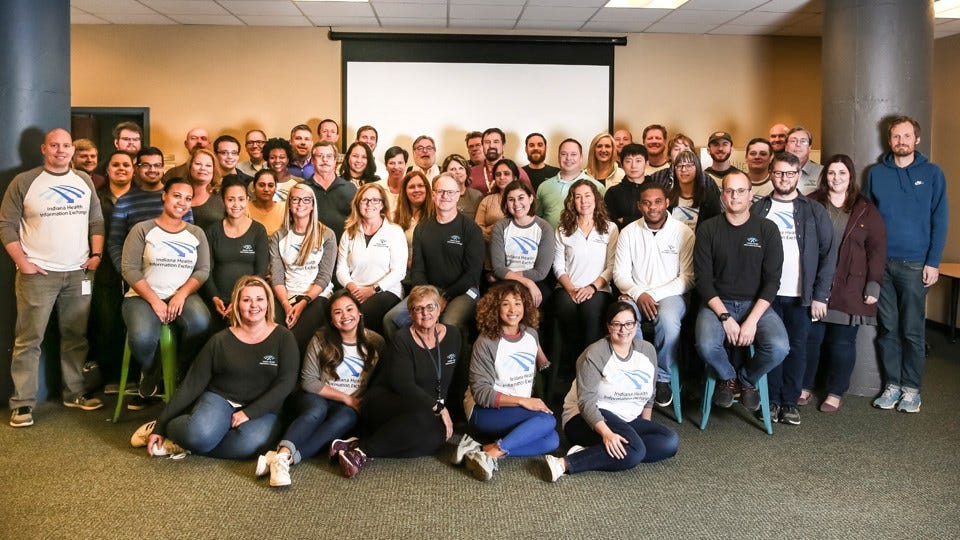Indiana Leads Charge for HIE Consolidation
 Beginning January 1
Beginning January 1
Subscriber Benefit
As a subscriber you can listen to articles at work, in the car, or while you work out. Subscribe NowElectronic health information exchange (HIE) has come a long way since its inception in the late 1990s when it seemed like a “crazy, out-of-the-box idea,” says one Hoosier health IT leader—but the now familiar concept has been plagued by fragmentation in the marketplace. Removing that fragmentation “is kind of our business,” explains Indiana Health Information Exchange (IHIE) President and Chief Executive Officer John Kansky, and a recent consolidation takes unification in the Hoosier state to the highest level yet.
An HIE allows healthcare providers to electronically share a patient’s electronic health record (EHR), no matter where patients are receiving care, such as specialists’ offices, labs, or emergency rooms; IHIE says it currently makes this information available to about 50,000 providers. Multiple HIEs within a state means systems can’t “talk” to each other to share a patient’s EHR.
“Everybody has an experience at some point where they’re frustrated by the fact that their doctor doesn’t know their lab result or have information that’s helpful to their care,” says Kansky.
Beginning January 1, 2020, there will be only one HIE in Indiana; IHIE and Michiana Health Information Network (MHIN), both nonprofits, are merging to become one organization.
“What if the lab result was done over here, then the lab result ends up being useful six months later over there? Or what if the claims data for that patient’s insurer is in IHIE, but they seek care in MHIN?” says Kansky. “It’s currently really complicated because it is fragmented, and the more unified and complete the HIE picture can be, the better for the quality, safety and cost-efficiency of healthcare. We’re trying to make it better.”
Earlier this year, Bloomington-based HealthLINC also began consolidating with IHIE. Bringing the three organizations under one umbrella also means providers statewide will no longer need to obtain HIE services from multiple organizations.
“There’s more crossover between the northern part of the state and central than people might think; there’s a lot of specialty care that people come down to Indy for,” says MHIN Chief Executive Officer Kelly Hahaj. “As consumers of technology, we’re accustomed to easily searching for movies, flights, or making restaurant reservations—so patients almost expect physicians to have access to their information wherever it is. They come to Indy for specialty care, and when they go back to their primary care in the northern part of the state, they expect that information to travel.”
Hahaj and Kansky say it’s only natural that Indiana would set an example of rising above fragmented HIEs. The state is known as a pioneer—if not the birthplace—of HIEs. MHIN, founded in 1998, pre-dates iPhones and social media, when such electronic sharing was a “crazy” idea, says Hahaj.
“Indiana is famous for being a pioneer in HIE. Sometimes I like to say we’re known for auto racing, Bobby Knight and HIE,” says Kansky. “For HIEs nationally, this is a longer story. HIE scale and consolidation make HIE a more valuable and stronger concept nationally. The federal government is watching [Indiana], and this is a positive step for HIE nationally too.”
IHIE and MHIN have been partnering with neighboring states for about two years, and the new unified organization is ramping up its interstate strategy; when patients move between Indiana and Michigan, for example, their providers are alerted and given a mechanism to get the clinical information from the encounter they had across the state line. Previously, that information was given only to providers who requested it.
Kansky acknowledges the consolidation doesn’t cover every provider and patient in Indiana; while “technology is not the barrier,” certain nuances in the system—“cooperation, standards, competition”—create “holes in the cheese.”
“I think [Indiana] is a bellwether for the need for scale in HIE,” says Kansky. “If we have every provider, insurance company, lab and physician practice all sharing information, then there aren’t any holes—but there are always going to be holes. MHIN and IHIE have been building, building, building on our networks and filling in every hole in the cheese that we can fill in. And we’re just going to keep doing that.”
Kansky says IHIE also provides tools for employers, such as its population dashboard product “PopDash,” which gives employers ongoing analysis of their workforce’s health.
Kansky says it’s important to get the word out about IHIE’s services, so providers and patients can take full advantage of the information.
Hahaj says MHIN’s smaller geography and IHIE’s broad experience are unique strengths of each exchange that will benefit the consolidated organization.
